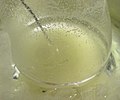chemistry, the Michael reaction or Michael 1,4 addition is a reaction between a Michael donor (an enolate or other nucleophile) and a Michael acceptor (usually...
27 KB (2,826 words) - 19:31, 22 May 2025
Organic Reactions. doi:10.1002/0471264180. ISBN 978-0-471-26418-7. Hunt, Ian. "Chapter 18: Enols and Enolates — The Michael Addition reaction". University...
66 KB (8,057 words) - 20:26, 4 June 2025
conjugate addition is a type of organic reaction. Ordinary nucleophilic additions or 1,2-nucleophilic additions deal mostly with additions to carbonyl...
6 KB (625 words) - 20:20, 5 March 2024
The Suzuki reaction or Suzuki coupling is an organic reaction that uses a palladium complex catalyst to cross-couple a boronic acid to an organohalide...
35 KB (3,984 words) - 17:56, 24 May 2025
The Stetter reaction is a reaction used in organic chemistry to form carbon-carbon bonds through a 1,4-addition reaction utilizing a nucleophilic catalyst...
19 KB (2,357 words) - 19:34, 9 March 2023
The Vilsmeier–Haack reaction (also called the Vilsmeier reaction) is the chemical reaction of a substituted formamide (1) with phosphorus oxychloride and...
5 KB (457 words) - 18:59, 26 September 2024
and Miles Corporation in the United States. It utilizes the aza-Michael addition reaction. These products are then used in coatings, adhesives, sealants...
8 KB (781 words) - 10:38, 25 May 2025
The aldol reaction (aldol addition) is a reaction in organic chemistry that combines two carbonyl compounds (e.g. aldehydes or ketones) to form a new...
40 KB (4,256 words) - 12:17, 6 June 2025
alkylation Nitro-Mannich reaction Crabbé reaction Aza-Baylis-Hillman reaction – Mannich addition to an enone Smith, Michael B.; March, Jerry (2007). March's...
10 KB (1,042 words) - 15:42, 2 June 2025
The nitro-Mannich reaction (or aza-Henry reaction) is the nucleophilic addition of a nitroalkane (or the corresponding nitronate anion) to an imine, resulting...
26 KB (2,894 words) - 15:33, 22 May 2025
Hydroamination (category Addition reactions)
Hydroamination reactions occur spontaneously only for electrophilic alkenes and some dienes, but these are known by other names (e.g. Michael addition reaction); "hydroamination"...
19 KB (1,795 words) - 23:21, 2 June 2025
uniform polymer networks. Thiol-ene reactions are known to proceed through a Michael addition pathway. These reactions are catalyzed by either a base or...
25 KB (2,808 words) - 12:29, 23 May 2025
Johnson and developed significantly by E. J. Corey and Michael Chaykovsky. The reaction involves addition of a sulfur ylide to a ketone, aldehyde, imine, or...
22 KB (2,314 words) - 02:29, 26 May 2025
Arthur Michael (August 7, 1853 – February 8, 1942) was an American organic chemist who is best known for the Michael reaction. Arthur Michael was born...
6 KB (665 words) - 09:54, 24 February 2025
Multiple Michael/aldol reaction (or domino Michael/aldol reaction) is a consecutive series of reactions composed of either Michael addition reactions or aldol...
3 KB (338 words) - 05:04, 15 August 2023
Nitroethylene (section Addition and Reduction)
In addition to standard nucleophilic addition reactions on the C=C bond, nitroethylene can serve as a Michael acceptor in a Michael addition reaction. A...
8 KB (846 words) - 07:20, 28 May 2025
reacts chemically with the protein keratin in skin and hair via a Michael addition reaction, resulting in a strong permanent stain that lasts until the skin...
7 KB (687 words) - 23:45, 5 August 2024
Robinson annulation (redirect from Wichterle reaction)
transformations termed Tandem Michael-aldol reactions, that sequentially combine Michael addition and aldol reaction into a single reaction. As is the case with...
15 KB (1,742 words) - 15:32, 24 May 2025
In organic chemistry, the Diels–Alder reaction is a chemical reaction between a conjugated diene and a substituted alkene, commonly termed the dienophile...
69 KB (7,937 words) - 05:25, 26 May 2025
by "A more modern interpretation extends the scope of the reaction to include the addition of Grignard reagents to a wide variety of electrophilic substrates...
12 KB (1,096 words) - 23:09, 23 May 2025
Dimedone (section Reaction with aldehydes)
Dimedone is prepared from mesityl oxide and diethyl malonate via a Michael addition reaction. Dimedone is in equilibrium with its tautomer in solution — in...
4 KB (235 words) - 20:37, 26 May 2025
Oxidative addition and reductive elimination are two important and related classes of reactions in organometallic chemistry. Oxidative addition is a process...
10 KB (1,210 words) - 14:57, 11 January 2025
Alkynylation (category Addition reactions)
In organic chemistry, alkynylation is an addition reaction in which a terminal alkyne (−C≡CH) is added to a carbonyl group (C=O) to form an α-alkynyl...
12 KB (1,249 words) - 06:08, 3 April 2025
The Sandmeyer reaction is a chemical reaction used to synthesize aryl halides from aryl diazonium salts using copper salts as reagents or catalysts. It...
16 KB (1,738 words) - 11:35, 22 April 2025
Hydrocyanation (category Addition reactions)
hydrocyanation is a process for conversion of alkenes to nitriles. The reaction involves the addition of hydrogen cyanide and requires a catalyst if the substrate...
9 KB (1,053 words) - 00:32, 25 May 2025
The Friedel–Crafts reactions are a set of reactions developed by Charles Friedel and James Crafts in 1877 to attach substituents to an aromatic ring. Friedel–Crafts...
22 KB (2,159 words) - 16:16, 24 May 2025
coupling. Click chemistry Michael addition Radical addition Thiol-ene reaction March, Jerry (1985). Advanced Organic Chemistry: Reactions, Mechanisms, and Structure...
18 KB (1,743 words) - 09:38, 28 May 2025
Aldol condensation (redirect from Claisen–Schmidt reaction)
first (addition) stage of the process—the aldol reaction itself—as catalyzed by aldolases. However, the first step is formally an addition reaction rather...
18 KB (1,816 words) - 18:28, 25 May 2025
the Baylis–Hillman, Morita–Baylis–Hillman, or MBH reaction is a carbon–carbon bond-forming reaction between an activated alkene and a carbon electrophile...
24 KB (2,831 words) - 07:34, 31 May 2025
Knoevenagel condensation (redirect from Knaevenagel reaction)
condensation is a nucleophilic addition of an active hydrogen compound to a carbonyl group followed by a dehydration reaction in which a molecule of water...
7 KB (729 words) - 10:15, 12 February 2025













